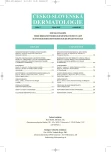Toxic Erythema of Chemotherapy
Authors:
I. Píchová; V. Plechatá
Authors‘ workplace:
Kožní oddělení, Oblastní nemocnice Kolín, a. s.
prim. MUDr. Věra Plechatá
Published in:
Čes-slov Derm, 86, 2011, No. 5, p. 236-239
Category:
Case Reports
Overview
Toxic Erythema of Chemotherapy (TEC) is a term summarizing cutaneous changes occurring due to chemotherapy as a result of an escalated toxic reaction. Acral erythema with painful erythematous patches localized, especially, on palms and soles belongs to the common types of TEC. Authors describe a case of 73-year old patient with the colon cancer with liver metastases in whom the acral erythema appeared after capecitabine administration.
Key words:
toxic erythema of chemotherapy – capecitabine
Sources
1. BOLOGNIA, J.,COOPER, D., GLUSAC, E. Toxic erythema of chemoterapy: A useful clinical term. J. Am. Acad. Dermatol., 2008, 59, p. 524–529.
2. ČEŠKA, R. et al. Interna. 1. vyd. Praha: Triton, 2010, s. 741. ISBN 978-80-7387-423-0.
3. CETKOVSKÁ, P., PIZINGER, K., ŠTORK, J. Kožní změny u interních onemocnění. 1. vyd. Praha: Grada Publishing, 2010, s. 177. ISBN 978-80-247-1004-4.
4. CETKOVSKÁ, P., PIZINGER, K. Kožní změny při chemoterapii hematologických nemocí. Čes-slov Derm., 2001, 76, 4, s. 199.
5. COX, G. J., ROBERTSON, D. B. Toxic erythema of palms and soles associated with hig-dose mercaptopurine chemotherapy. Arch. Dermatol., 1986, 122, p. 1413–1414.
6. DUŠEK, L., MUŽÍK, J., KUBÁSEK, M., KOPTÍKOVÁ, J., ŽALOUDÍK, J., VYZULA, R. Epidemiologie zhoubných nádorů v České republice [online]. Dostupný na www: www.kolorektum.cz
7. FABIAN, C. J., MOLINA, R., SLAVÍK, M. Pyridoxine therapy for palmar-plantar erythrodysesthesia associated with continous 5-fluorouracil infusion. Invest. New Drugs, 1990, 8, 1, p. 57–63.
8. KUBECOVÁ, M. Capecitabine. Čes-slov Farmakoterapie, 2005, Suppl. 1, s. 49–51.
9. LOKICH, J. J., MOORE, C. Chemotherapy-associated palmar-plantar erythrodysesthesia syndrome. Ann. Intern. Med., 1984, 101, 6, p. 798–799.
10. LORRUSO, D., DI STEFANO, A., CARONE, V., FAGOTTI, A., PISCONTI, S., SCAMBIA, G. Pegylated liposomal doxorubicin-related palmar-plantar erythrodysesthesia, (‘hand-foot’ syndrome). Annals of Oncology, 2007, 18, 7, p.1159–1164. doi:10.1093/annonc/mdl477.
11. MILANO, G., ETIENNE-GRIMALDI, M.-C., MARI, M. et al. Candidate mechanisms for capecitabine related hand-foot syndrome. Br. J. Clin. Pharmacol., 2008, 66, 1, p. 88–95.
12. MIŇOVSKÁ,V. Palmoplantární erytrodysestezie vyvolaná liposomálním doxorubinem. Čes.-slov. Derm., 2003, 78, 4, s. 159–161.
13. NAGORE, E., INSA, A., SANMARTIN, O. Antineoplastic therapy-induced palmar plantar erythrodysesthesia (‘hand-foot’) syndrome: incidence, recognition and management. Am. J. Clin. Dermatol., 2000, 1, 4, p. 225–234.
14. XELODA produktová monografie. Dostupný na www: www.xeloda.cz.
15. VORLÍČEK, J. Klinická onkologie. 2. díl, 1. vyd. MU Brno, 1996, s. 482, ISBN 80-2101257-9.
16. ZUEHLKE, R. L. Erythematous eruption of palms et soles associated with mitotane therapy. Dematologica, 1974, 148, s. 90–92.
Labels
Dermatology & STDs Paediatric dermatology & STDsArticle was published in
Czech-Slovak Dermatology

2011 Issue 5
Most read in this issue
- Chlamydial Infections
- Toxic Erythema of Chemotherapy
- Scabies Crustosa in an Infant
-
Léčba psoriázy v roce 2011
(komentovaný přehled novinek z amerických a německých doporučených postupů se zaměřením na ustekinumab)
